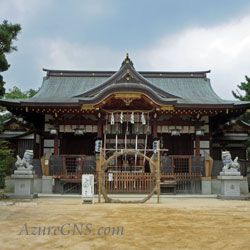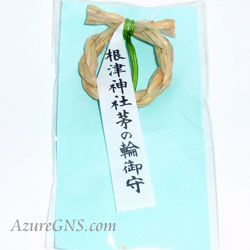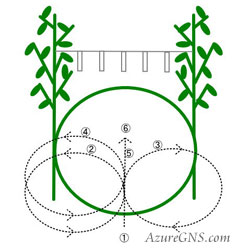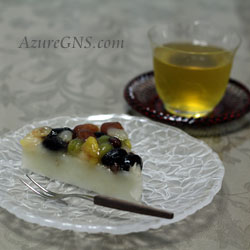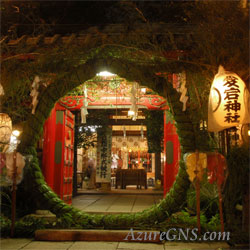(6月30日又は7月末)
Nagoshi-no-Harae;
The Great Summer Purification
(June 30th or at the end of July)
●夏越の祓 Nagoshi-no-harae; the Great Summer Purification
●年越しの祓 Toshikoshi-no-harae; the Great End of Year Purification
●大祓 O-harae; the Great Purification
●茅の輪 Chi-no-wa; the circle gate of Japanese bloodgrass
●茅;チガヤ Japanese bloodgrass; blade grass; cogon grass; kunai grass
●藁 straw
●神社 a shrine
●宮司 a chief priest of s Shinto shrine
●神事 Shinto ritual
●祈祷 prayer
●祈祷する (to) pray
●無病息災 perfect health; sound health; good health
●疫病 epidemic disease
◆古来より6月と12月の晦日(つごもり)、つまり新暦の6月30日と12月31日に、大祓(おおはらえ、おおはらい)と呼ばれる神事が神社で行われます。
Since ancient times, the Shinto rituals of O-harae (the great purification) have been performed in shrines on Tsugomori days in June and December (on June 30th and December 31st according to the solar calendar).
◆半年間、日々の暮らしの中で犯した罪や過ち、そして心身の穢れを祓い、無事に過ごせた人は感謝すると共に、これからの半年の無病息災を祈願するために神社に行きます。
People go to the shrines to be purified of all sins, faults and defilements of mind and body, thank deities for their peaceful and healthy life during the past 6 months and pray for good health for the next six months.
◆毎年6月30日に行われる大祓は夏越の祓、12月31日の大祓は年越しの祓と呼ばれます。
O-harae on June 30 is called Nagoshi-no-harae, and O-harae on December 31st is called Toshikoshi-no-harae.
◆夏越の祓は神社や地方によっては7月末頃に行われることもあり、夏越の御禊(なごしのみそぎ)、水無月の祓(みなづきのはらえ)、輪越祭(わごしまつり)と呼ばれることもあります。
In some shrines and districts, Nagoshi-no-harae is performed at the end of July and has other names such as Nagoshi-no-misogi, Minazuki-no-harae or Wagoshi-matsuri.
◆夏越の祓では茅の輪(ちのわ)くぐりと呼ばれている神事が行われます。
Chi-no-wa-kuguri of a Shinto ritual is performed in Nagoshi-no-harae.
◆茅(ち又はかや)はイネ科の多年草で、日本の地方の伝統的な屋根を葺くのにしばしば使われます。
Chi or kaya is a perennial plant of the Poaceae family and is often used for thatching roofs of traditional Japanese houses in the countryside.
◆茅の輪は茅や藁で編んだ直径2、3メートルの大きな輪で、笹を2本立ててその間に注連縄を張った下や、鳥居や神門の下に設けます。
Chi-no-wa is a big circular gate which is a few meters in diameter and made of Japanese bloodgrass or straw, and Chi-no-wa is placed under shime-nawa (a sacred cord made of twisted straw and pieces of paper) between two bamboo poles, under torii (a gate without a roof or a door at the entrance of a Shinto shrine) or shin-mon (a gate with a roof and a door at the entrance of a Shinto shrine).
◆宮司に続き一般参拝者が茅の輪を8の字を描くようにくぐります。
The worshipers following the chief priest of the Shinto shrine and pass through Chi-no-wa so as to draw the letter 8.
以下の順序で茅の輪をくぐります。
People pass through Chi-no-wa in the following order;
全ての礼は深くします。
Bow deeply every time.
(1) 茅の輪の正面に立ちます。
(1) Stand squarely in front of Chi-no-wa.
(2) 一礼して、茅の輪を左回りにくぐり、正面(1)に戻ります。
(2) After bowing, go through it counterclockwise and return to the front (1).
(3) 一礼して、茅の輪を右回りにくぐり、正面(1)に戻ります。
(3) After bowing, go through it clockwise and return to the front (1).
(4) 一礼して、再び茅の輪を左回りにくぐり、正面(1)に戻ります。
(4) After bowing, go through it counterclockwise again and return to the front (1).
(5) 一礼して、茅の輪をまっすぐくぐり、御神前まで進みます。
(5) After bowing, go straight through it toward the altar.
(6) 二礼二拍手一礼をしてお参りします。
(6) Bow twice, clap hands twice and bow once before praying.
◆茅の輪をくぐりながら、神社によって様々な詞を唱えます。
People recite some chants which vary with shrines when they are going through Chi-no-wa.
◆以下がその例です。
The examples are shown below:
「水無月の 夏越の祓へ する人は 千歳の命 延ぶというなり」 (みなづきの なごしのはらへ するひとは ちとせのいのち のぶというなり)
“Minazuki no Nagoshi-no-harae suru-hito wa chitose no inochi nobu to iunari.”
(It is said that the people who receive the Great Summer Purification in June can live for 1,000 years.)
「祓い給え 清め給へ 守り給へ 幸へ給へ」 (はらいたまえ きよめたまえ まもりたまえ さきわえたまえ)
“Harai-tamae kiyome-tamae mamori-tamae sakiwae-tamae.”
(Please exorcise me, purify me, protect me and bless me.)
「蘇民将来子孫也」(そみんしょうらいしそんなり)
“Somin shorai shison-nari.”
(I am Somin Shorai’s descendant.)
◆茅の輪の起源は奈良時代(710-794)初期に遡り、『備後国風土記』(びんごのくにふどき)の中にその記述があります。
The origin of Chi-no-wa dates back to the Nara period (710-794), and “Bingo-no-kuni-fudoki” (a book about the history and culture of the eastern part of present-day Hiroshima Prefecture) has descriptions about it.
◆素戔嗚尊(すさのおのみこと)(神道の神)が身分を隠して旅をしている途中で、土民の兄弟に宿を乞われました。
Susano-no-Mikoto (the Shinto god) concealed his identity and asked the native brothers for a night’s lodging.
◆裕福な弟の巨旦将来(こたんしょうらい)は断り、貧しい兄の蘇民将来(そみんしょうらい)は精一杯もてなしました。
Kotan Shorai, the wealthy younger brother, rejected him, but Somin Shorai, the poor elder brother, entertained him as much as possible.
◆素戔嗚尊はお礼に茅の輪を腰に着けると疫病から逃れられると教えました。
As a token of gratitude, Susano-no-Mikoto told him that Chi-no-wa worn on the waist would protect him from epidemic diseases.
◆この教えを守った蘇民とその子孫は生涯幸せに暮らすことができました。
Somin and his descendants could live a happy life following this teaching.
◆形代流し(かたしろながし)も夏越の祓の神事のひとつです。
Katashiro-nagoshi is also one of the Shinto rituals of Nagoshi-no-harae.
◆人の形に紙を切り取った人形代(ひとかたしろ)、または人形に氏名と年齢を書き、息を吹きかけたり、指でさすったり、体の悪い所にこすりつけて、罪や穢れを移します。
After people write their names and ages on Katashiro (a piece of paper shaped like the figure of a man), they breathe on it, stroke it with their fingers or rub it against their physically troubled body parts so that they should transfer their sins and defilements to it.
◆神事の後、形代は川や海に流されます。
After the Shinto ritual, Katashiro are put into a river or the sea to float away.
◆夏越の祓の日に水無月(みなづき)と呼ばれる、白い外郎(ういろう)に甘く煮た小豆を載せ、氷をかたどった三角形に切った和菓子が特に関西地方で食べられます。
On the day of Nagoshi-no-harae, people especially in the Kansai Region eat Minazuki, white Uiro (traditional chewy Japanese steamed cake made of rice flour and sugar) topped with sweetened red beans and cut into a triangular shape resembling ice.
◆かつて冷凍庫の無い時代は氷は氷室に保存されていて、夏場は大変貴重で高価だったので庶民が口にすることはできませんでした。
In the old times when there were no refrigerators, ice was stored in an ice house, and ice was so valuable and expensive in summer that ordinary people could not afford it.
◆そこで氷の代わりに京都で水無月が食べられるようになり、その風習は関西地方へ広まりました。
Therefore, people in Kyoto started to eat Minazuki instead of ice, and this custom spread in the Kansai Region.
◆夏越の祓は俳句の夏の季語になっています。
Nagoshi-no-harae is a seasonal word of Haiku (a Japanese traditional short poem of 17 syllables arranged in a 5-7-5 pattern).
(より詳しい情報は「我が家の夏越の祓」をご覧下さい。)
(Please see “Our Great Summer Purification Experience” for further information.)
Copyright (C) Azure Global Network Services. All Rights Reserved.
